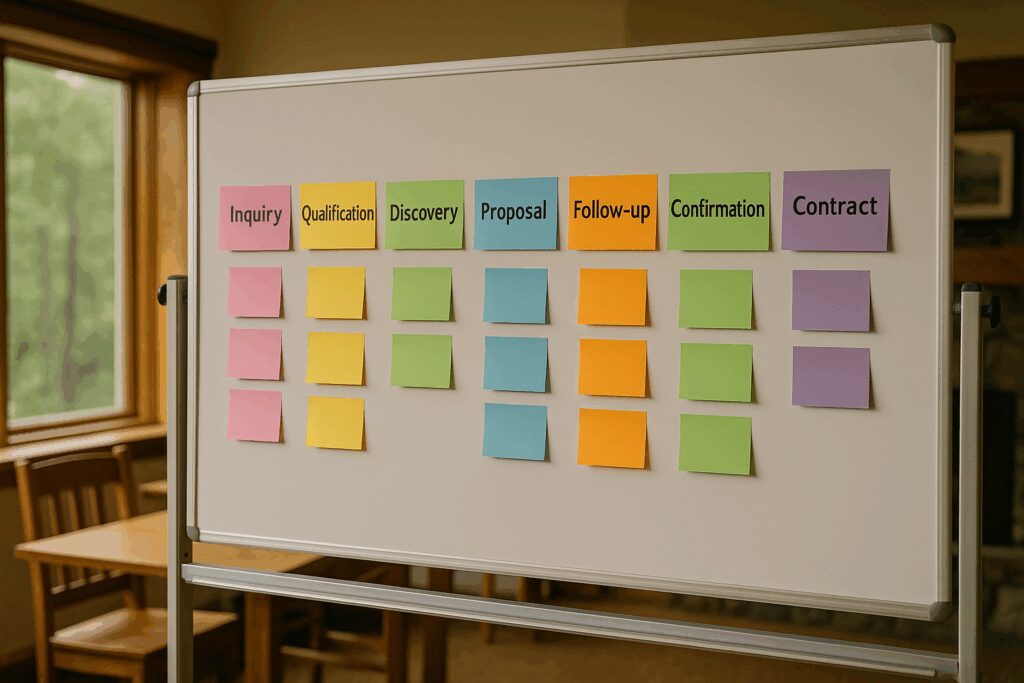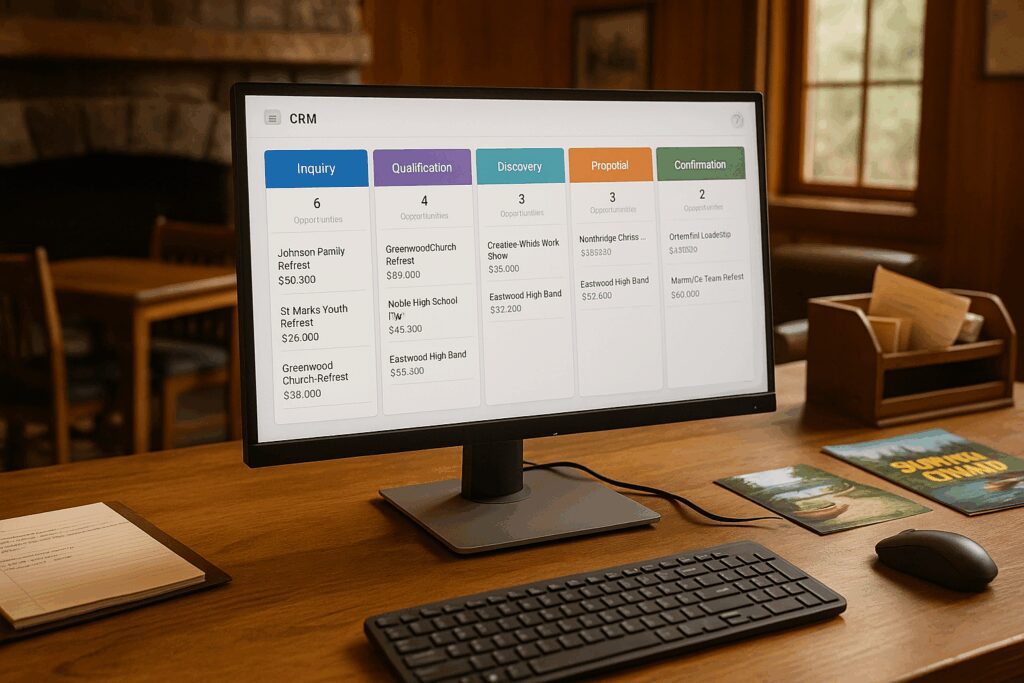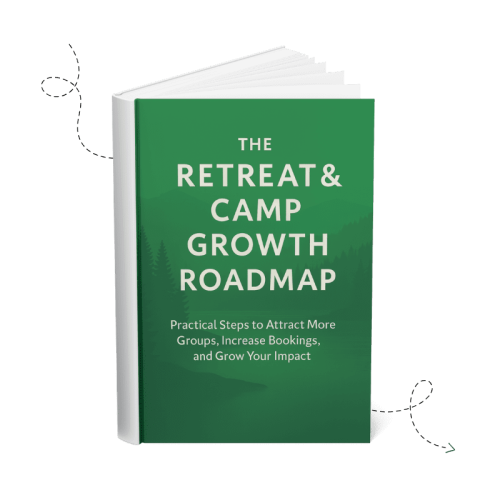Retreat & Camp Growth Roadmap Focus Area: Implement Sales Pipeline
Introduction
When a group reaches out about hosting a retreat, it’s a moment filled with potential. But without a system to track where they are in the decision process, important details get lost, follow-ups are delayed, and opportunities slip away.
Maybe you’ve had a group disappear after you sent a quote, only to hear later that they booked somewhere else. Or you’ve wished you had better notes when a date unexpectedly opened up. Or maybe you’ve let a rebooking conversation slip past the right moment. Or perhaps a group asked about fall dates, you told them you were full, and when another group canceled, you couldn’t remember who to call back.
A sales pipeline changes that. It’s a simple way to see exactly where every group is—from their first inquiry through rebooking—so you can respond quickly, follow up consistently, and keep your calendar full.
Why This Focus Area Matters
Each inquiry represents people who may experience life change at your retreat center. Stewardship means making the most of those opportunities. A sales pipeline helps you do that by:
- Staying on top of every opportunity. No more “Did anyone follow up with that group?” moments.
- Improving booking success. Consistent follow-up turns more inquiries into signed contracts.
- Gaining clarity as a team. Everyone knows who’s responsible for the next step.
- Seeing the bigger picture. Leaders can forecast bookings, spot weak points, and celebrate wins.
- Reducing stress. Without a pipeline, directors often feel like they’re juggling too many details in their heads — and that stress multiplies as inquiries grow.
For small centers, a pipeline can be as simple as sticky notes on a whiteboard. For larger teams, it becomes the backbone of sales and guest services. Either way, it’s the tool that turns chaos into clarity.
Is This an Area You Need to Focus on Right Now?
Ask yourself:
- Do you only start tracking groups once you’ve sent a proposal or estimate?
- Do details ever slip through the cracks as groups move from interest to contract?
- Is it unclear who owns the next step with a group at any given time?
- Do you lack a reliable way to forecast future bookings?
If you answered “no” to any of these, implementing a sales pipeline can help you bring greater clarity, alignment, and impact to your outreach.
Putting This Focus Area into Practice
What Is a Sales Pipeline?
A sales pipeline is a visual system for managing where each group is in your retreat booking process.
- Pipeline: the full path a group follows, from first inquiry to rebooking.
- Stages: the distinct steps along the way (e.g., Proposal Sent, Contract Signed).
- Opportunities: each group you’re working to book.
The pipeline doesn’t make things more complicated—it makes them visible, so nothing falls through the cracks.
Even if all you do at first is sketch your stages on a whiteboard and move sticky notes for each group, that’s a pipeline in action.
The Standard Retreat Sales Pipeline
While every center’s process is unique, most retreat sales pipelines follow these seven core stages:
- Initial Inquiry – Group reaches out by form, phone, or email. You capture basic details (dates, group type, size) and acknowledge promptly.
- Response & Qualification – You confirm if they’re a good fit, clarify needs, and offer a next step.
- Discovery Call or Tour – You build rapport, learn their goals and budget, and align with what you offer.
- Proposal or Quote Sent – You send pricing, available dates, and a clear next step for decision-making.
- Follow-up & Decision Support – You check in regularly, answer questions, and guide them toward a decision.
- Booking Confirmation – They verbally or in writing confirm. You send the contract and deposit invoice.
- Signed Contract & Deposit – The group is officially booked, and you hand them off to planning.
This framework ensures you’re tracking from the first inquiry, not halfway through, and continuing through the signed contract and beyond.
Why Clear Stages Matter
Some retreat centers use vague steps like “Working on details” or “Pending.” The problem? Nobody knows exactly what that means—or who owns the next move.
One director we worked with had a dozen opportunities sitting in “Pending.” When they dug deeper, some were already lost, some had contracts out, and some were waiting for a call back. The vague stage created confusion and lost time. When they renamed and clarified stages, it became obvious where to focus — and they started moving opportunities forward faster.
A better approach is clear, distinct milestones with natural handoffs. For example:
- Instead of “Pending,” use “Proposal Sent.”
- Instead of “Working on details,” use “Estimate Finalized.”
Clear stages prevent confusion, reduce delays, and create accountability. Everyone can see where a group stands and what needs to happen next.
Mapping Your Sales Process
Start by mapping your pipeline on paper before setting it up in software.
- Write down each stage of your process.
- Keep it simple: 5–7 clear steps is ideal, but no less than 3, and now more than 10
- Make sure each stage has a clear entry point and exit point.
- Involve your team in defining the stages, so the pipeline reflects reality and gets buy-in.
If you’d like to see an example of a mapped out sales process, you can download our sales process mapping worksheet, which includes an example of a retreat sales process.

Expanding Beyond the Initial Sales Pipeline
Once you’ve built confidence tracking the initial sales process—from inquiry to signed contract—the next opportunity is to expand your tracking into the planning and rebooking stages.
Why does this matter?
- Planning pipeline tracking ensures smooth communication, avoids missed details, and improves the guest experience. When groups feel supported and confident during planning, they’re far more likely to return.
- Rebooking tracking keeps the focus on the long-term relationship. Instead of a retreat ending at checkout, you intentionally move the group toward their next booking.
A Typical Second Pipeline Might Look Like:
- Contract Signed (handoff from Pipeline One)
- Initial Planning Call
- Numbers & Room Assignments Finalized
- Activities & Meals Scheduled
- Check-In Arrangements Confirmed
- Retreat Completed
- Feedback Collected
- Final Invoice Settled
- Rebooking Discussed
This second pipeline helps you support groups better, deliver a smoother experience, and increase the likelihood of rebooking.
Why CRM Choice Matters
Most camp management systems are built for handling logistics—rooms, meals, activities—but they typically don’t track multiple pipelines or capture rebooking conversations. That’s where a dedicated CRM like LeadHub CRM becomes valuable.
LeadHub CRM allows you to:
- Run multiple pipelines side by side (sales + planning/rebooking).
- Automate reminders and handoffs between sales and guest services.
- Sync data with your camp management system to avoid duplicate work.
This integration ensures that the group experience is seamless—from first inquiry through their next booking.
CRM and Tracking Tools
Some retreat centers already use camp management systems that handle parts of the planning stage (room assignments, meals, activities). But those tools often don’t capture the early inquiry stages or the rebooking conversation.
That’s where a dedicated CRM (Customer Relationship Management system) adds value:
- Tracks every inquiry from the moment it arrives.
- Centralizes all conversations in one place.
- Automates reminders and follow-ups so no group is forgotten.
- Can integrate with your camp management system to avoid duplicate work.
The best scenario is a CRM that automatically captures inquiries from online forms and even phone calls, so every lead is tracked without manual entry.
Pipeline Management and Reporting
A pipeline isn’t just a tracker—it’s also a powerful reporting tool.
With reporting, you can see:
- Win rate: How many inquiries actually turn into bookings.
- Stage-to-stage conversion: For example, if 20 inquiries come in, 15 make it to proposal, but only 3 sign contracts, your win rate is 20%. That shows you exactly where to focus your attention.
- Time in stage: If groups are stalling in “Follow-up,” it may signal a bottleneck in communication.
Imagine you see that 80% of inquiries make it to proposal, but only 10% of proposals become bookings. That’s a clue you’re either sending proposals too soon, or not following up effectively. On the other hand, if most groups never make it past the inquiry stage, the issue may be response time. Reporting turns those patterns into clear action steps.
Pipeline reporting helps you evaluate performance, pinpoint problems, and identify opportunities for improvement.

Looking Ahead: Future Opportunities
Once your pipeline is mapped and in use, the next level is automation. Imagine:
- An automatic email sent when a proposal is delivered, offering a helpful guide.
- A reminder text two weeks before their retreat to confirm final numbers.
- A thank-you message after checkout that includes a rebooking link.
For example, when a group moves to the “Proposal Sent” stage, the system could automatically send a friendly email with your FAQs and a testimonial video. That thoughtful touch keeps you top-of-mind while they’re deciding.
This is where LeadHub CRM shines. Built for retreat centers, it not only tracks every lead but also automates communications and tasks based on a group’s stage in the pipeline. That’s a focus area we’ll cover in depth later, but it starts with getting your pipeline in place today.
Sales Pipeline Mapping Worksheet
To help you put this into practice, we’ve created a Sales Pipeline Mapping Worksheet that walks you step by step through mapping your own retreat sales pipeline. The worksheet includes an example of a completely mapped retreat sales process as a reference point.
📥 Download the Sales Pipeline Mapping Worksheet
This worksheet gives you a practical way to move from ideas to action. By laying out your own stages clearly, you’ll spot gaps in your current process and create a shared framework your team can actually use. Whether you’re a team of one or managing a larger staff, the worksheet will help you build a pipeline that fits your retreat center and keeps every opportunity moving forward.
Mini Case Study
A conference center we worked with had a somewhat defined sales process, but no systematic tracking. When they were smaller, this worked fine — staff could keep things straight in their heads. But as they grew, cracks began to show.
They sometimes failed to follow up with groups after sending a quote, only to find those groups had booked elsewhere or come back after deadlines had passed. When dates that were previously unavailable opened up, they had no way to quickly identify which groups had shown interest in those timeframes. They also frequently overlooked rebooking opportunities because reminders weren’t in place.
We helped them implement pipeline tracking with LeadHub CRM. First, we worked together to map their sales process clearly. Then we built a customized pipeline that matched those steps and added fields to capture key details at just the right stage. We transformed their usual communications into templates that could automatically trigger when a group advanced. Finally, we integrated their website so that new inquiries flowed directly into the pipeline and received an info packet instantly.
Before, their staff would scramble through email threads when someone asked, “What’s the status of the Smith group?” Afterward, it was one click on the dashboard. Instead of missed follow-ups and awkward apologies, they began hearing things like, “Thanks for staying on top of us—we really appreciate how easy you’ve made this.”
The “before” was stressful and reactive. The “after” was clarity and confidence: a dashboard view of every opportunity, automated next steps, and a reliable system for both new bookings and rebookings.

Putting It All Together
Implementing a sales pipeline is about stewardship, not sales pressure. It ensures no group slips through the cracks and gives you the visibility to make better decisions.
Key takeaways:
- Start tracking groups at the initial inquiry—not later in the process.
- Use the seven standard stages as a baseline and adapt them to your center.
- Define clear, distinct handoffs so accountability is never fuzzy.
- Expand tracking into planning and rebooking to improve guest satisfaction and increase repeat bookings.
- Leverage reporting to evaluate win rates, stage conversions, and bottlenecks.
- Consider tools like LeadHub CRM to automate tracking and integrate with your existing systems.
Ready to Take the Next Step?
If your center has ever lost a lead, forgotten to follow up, or missed a rebooking window, you know the cost of not having a pipeline. The good news is: building one is simple and powerful.
If you found this helpful, here are four great next steps to continue your journey:
🧭 Move to the Next Focus Area: Automate Meeting Scheduling
Learn how to connect calendar tools to let retreat planners easily book intro or planning calls.
[Read Automate Meeting Scheduling Focus Area Article]
📘 Download the Retreat & Camp Growth Roadmap eBook
Get the full 3-stage system we use to help retreat centers and camps grow with clarity and purpose.
[Download the eBook]
🌱 Learn More About How We Help Retreat Centers & Camps
We’re a Christian-owned digital marketing agency that helps retreat centers and camps grow attendance, bookings, and impact through practical strategies rooted in clarity and stewardship.
[See How We Can Help]
🤝 Schedule a Free Discovery Call
Want help applying this to your unique situation? Let’s talk. We’ll explore where you are now, where you want to go, and how to take the next faithful step.
[Book a Discovery Call]
You don’t have to figure this out alone. Let’s build something meaningful—together.
Frequently Asked Questions
1. What is a sales pipeline in plain language?
A sales pipeline is a visual system that shows where each group is in the booking process. It helps you stay organized, follow up effectively, and avoid missed opportunities.
2. Why is it important to track from the initial inquiry?
If you only track once you’ve sent an estimate, you miss the critical early steps where many inquiries drop off. Tracking from inquiry helps you capture every lead and respond quickly.
3. What are the typical steps in a retreat sales pipeline?
Most pipelines include: Initial Inquiry, Response & Qualification, Discovery Call/Tour, Proposal Sent, Follow-up, Booking Confirmation, and Signed Contract & Deposit.
4. How does this differ from my camp management system?
Camp management systems often handle planning logistics (rooms, meals, activities). A CRM pipeline complements this by tracking leads, proposals, and rebooking opportunities.
5. Isn’t this too “sales-y” for a retreat center?
Not at all. A pipeline isn’t about pressure—it’s about stewardship. It helps you serve groups well and follow through on opportunities God places in your path.
6. What if we only get a few inquiries per month?
Even then, a pipeline is valuable. With fewer inquiries, each one matters more, and tracking ensures none are missed. For example, if you only get five inquiries this season and lose track of one, that’s 20% of your opportunities gone.
7. What kind of metrics can we track with a pipeline?
You can track win rates, stage-to-stage conversions, and time spent in each stage. For example, if 20 inquiries turn into 15 proposals but only 3 contracts, you know exactly where to focus your improvement.
8. How can pipeline reporting improve our performance?
By showing you where groups are stalling, you can address bottlenecks. If many inquiries never reach the proposal stage, maybe your initial response needs strengthening.
9. Do we need a CRM to manage a pipeline?
You can start with a simple spreadsheet, but a CRM saves time and captures every lead automatically. It also integrates with forms, emails, and calls, which reduces manual work.
10. How does LeadHub CRM fit in?
LeadHub CRM is built with retreat centers in mind. It captures every inquiry, supports multiple pipelines (sales + planning/rebooking), integrates with your camp management system, and can automate reminders and communications as groups move through the pipeline.





